Property Investment and Finance: Economic Factors in Australia
VerifiedAdded on 2022/10/10
|9
|1441
|215
Essay
AI Summary
This essay delves into the intricacies of property investment and finance within the Australian context. It begins by analyzing the economic and non-economic factors influencing housing demand, including interest rates, building approvals, and rental prices. The essay then explores the significance of negative gearing in Australia, examining its mechanics, historical popularity, and current relevance. The analysis considers the impact of economic trends and government policies on investment strategies, particularly focusing on a rental house in Mackay, Queensland. The essay utilizes data and figures to support its arguments, offering a comprehensive overview of the Australian housing market and the factors shaping its dynamics. The conclusion summarizes the key findings and highlights the interplay between economic forces and investment decisions. Furthermore, the essay discusses the mechanics of negative gearing, its historical context, and its current attractiveness, while also considering future prospects and relevant investment parameters.
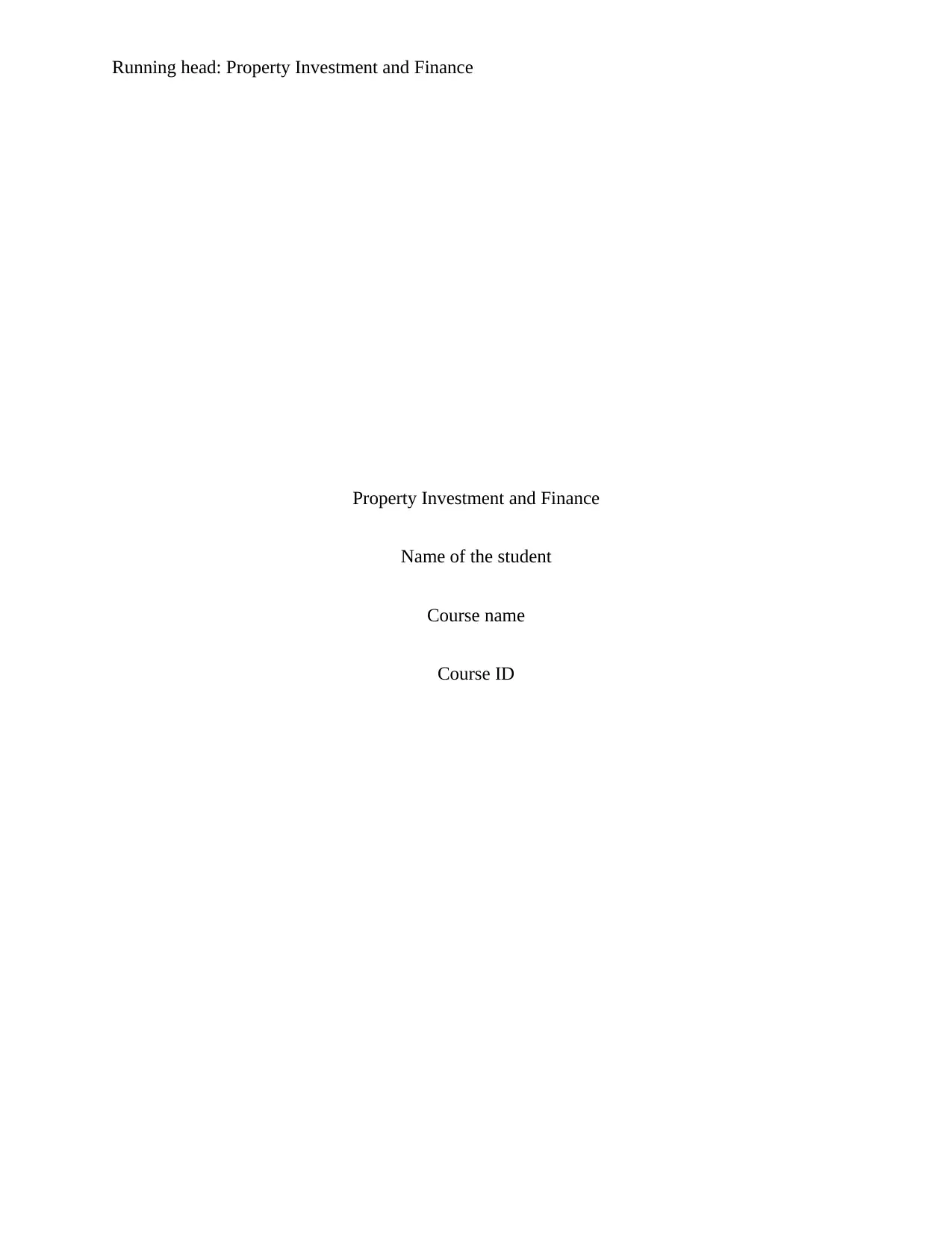
Running head: Property Investment and Finance
Property Investment and Finance
Name of the student
Course name
Course ID
Property Investment and Finance
Name of the student
Course name
Course ID
Paraphrase This Document
Need a fresh take? Get an instant paraphrase of this document with our AI Paraphraser
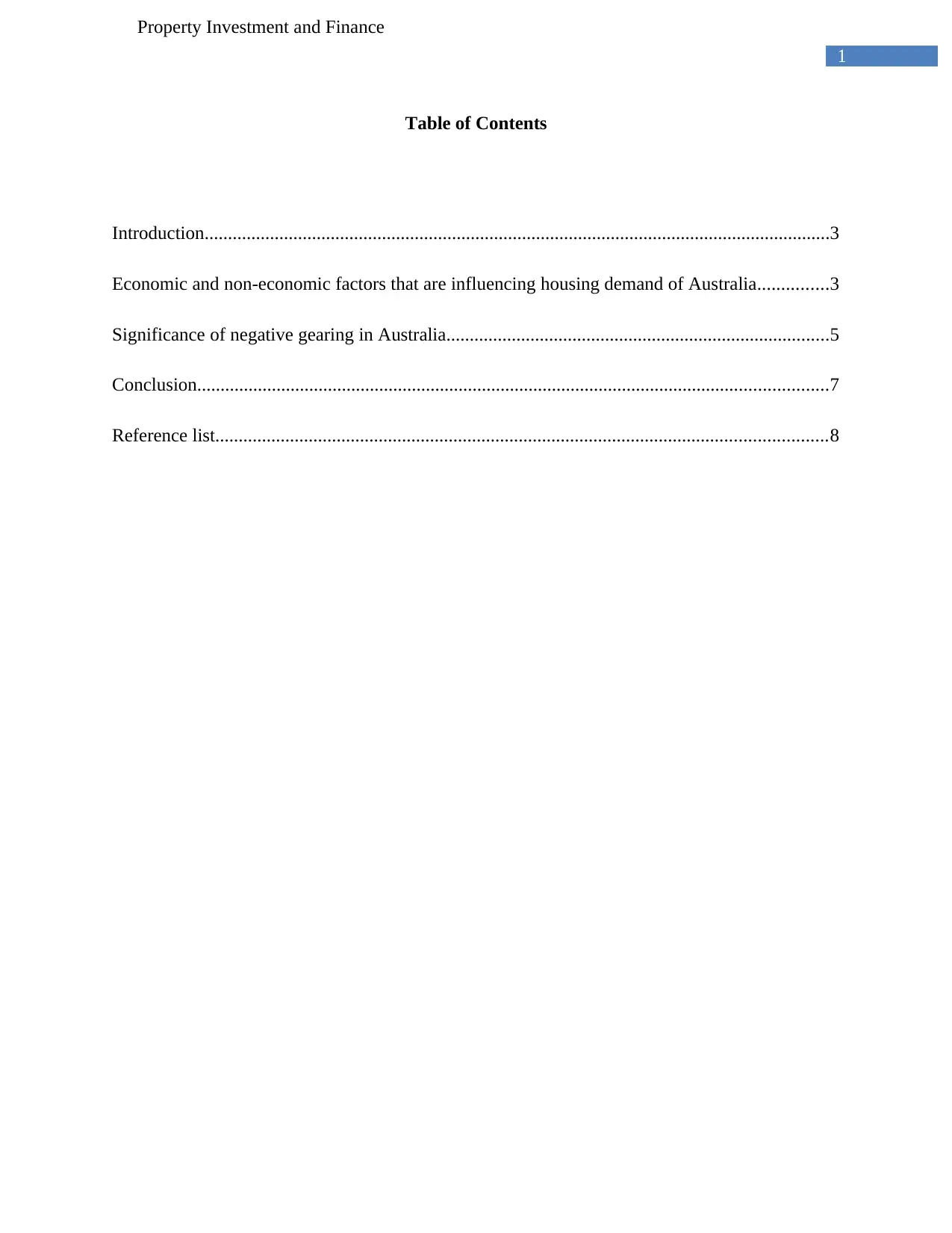
1
Property Investment and Finance
Table of Contents
Introduction......................................................................................................................................3
Economic and non-economic factors that are influencing housing demand of Australia...............3
Significance of negative gearing in Australia..................................................................................5
Conclusion.......................................................................................................................................7
Reference list...................................................................................................................................8
Property Investment and Finance
Table of Contents
Introduction......................................................................................................................................3
Economic and non-economic factors that are influencing housing demand of Australia...............3
Significance of negative gearing in Australia..................................................................................5
Conclusion.......................................................................................................................................7
Reference list...................................................................................................................................8
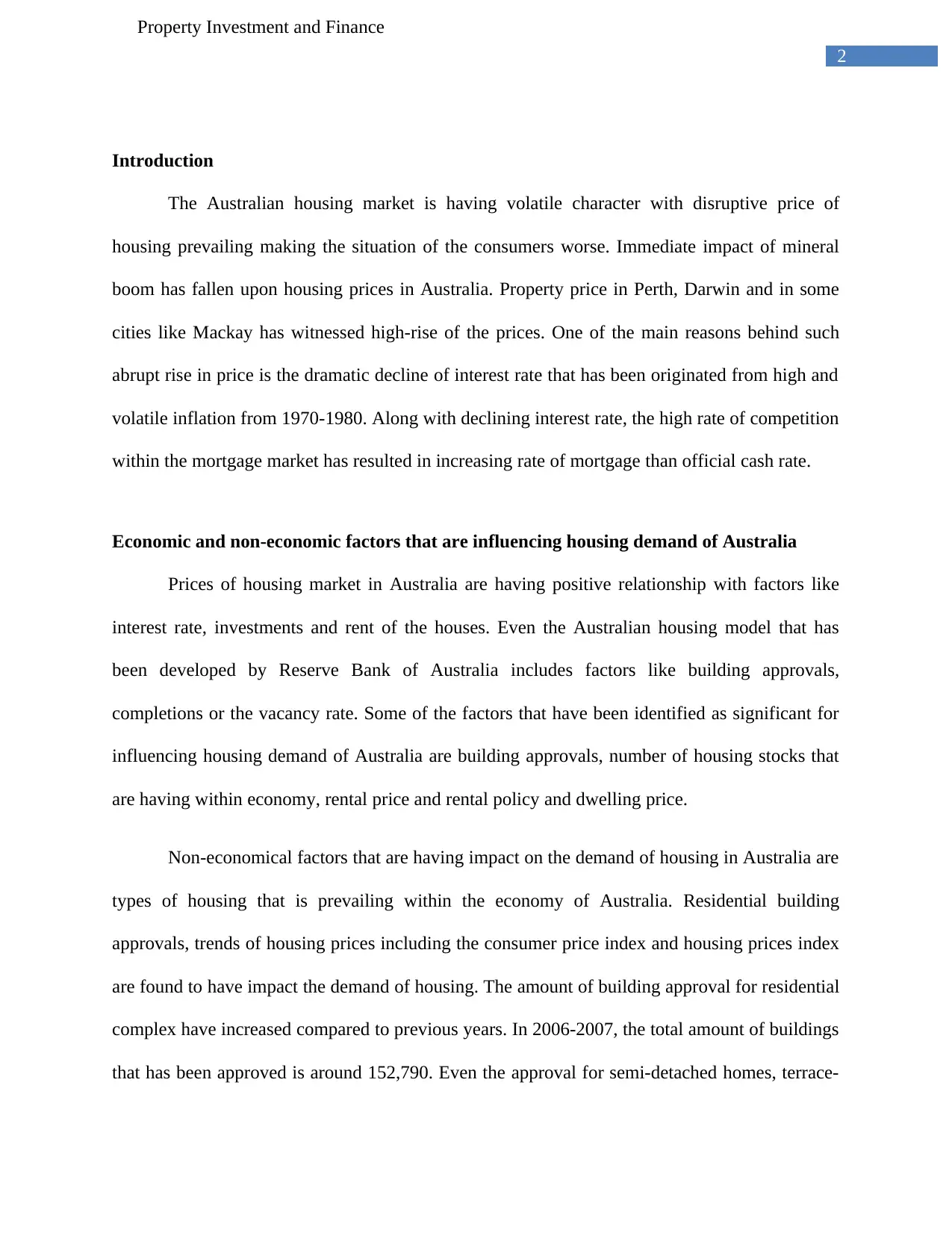
2
Property Investment and Finance
Introduction
The Australian housing market is having volatile character with disruptive price of
housing prevailing making the situation of the consumers worse. Immediate impact of mineral
boom has fallen upon housing prices in Australia. Property price in Perth, Darwin and in some
cities like Mackay has witnessed high-rise of the prices. One of the main reasons behind such
abrupt rise in price is the dramatic decline of interest rate that has been originated from high and
volatile inflation from 1970-1980. Along with declining interest rate, the high rate of competition
within the mortgage market has resulted in increasing rate of mortgage than official cash rate.
Economic and non-economic factors that are influencing housing demand of Australia
Prices of housing market in Australia are having positive relationship with factors like
interest rate, investments and rent of the houses. Even the Australian housing model that has
been developed by Reserve Bank of Australia includes factors like building approvals,
completions or the vacancy rate. Some of the factors that have been identified as significant for
influencing housing demand of Australia are building approvals, number of housing stocks that
are having within economy, rental price and rental policy and dwelling price.
Non-economical factors that are having impact on the demand of housing in Australia are
types of housing that is prevailing within the economy of Australia. Residential building
approvals, trends of housing prices including the consumer price index and housing prices index
are found to have impact the demand of housing. The amount of building approval for residential
complex have increased compared to previous years. In 2006-2007, the total amount of buildings
that has been approved is around 152,790. Even the approval for semi-detached homes, terrace-
Property Investment and Finance
Introduction
The Australian housing market is having volatile character with disruptive price of
housing prevailing making the situation of the consumers worse. Immediate impact of mineral
boom has fallen upon housing prices in Australia. Property price in Perth, Darwin and in some
cities like Mackay has witnessed high-rise of the prices. One of the main reasons behind such
abrupt rise in price is the dramatic decline of interest rate that has been originated from high and
volatile inflation from 1970-1980. Along with declining interest rate, the high rate of competition
within the mortgage market has resulted in increasing rate of mortgage than official cash rate.
Economic and non-economic factors that are influencing housing demand of Australia
Prices of housing market in Australia are having positive relationship with factors like
interest rate, investments and rent of the houses. Even the Australian housing model that has
been developed by Reserve Bank of Australia includes factors like building approvals,
completions or the vacancy rate. Some of the factors that have been identified as significant for
influencing housing demand of Australia are building approvals, number of housing stocks that
are having within economy, rental price and rental policy and dwelling price.
Non-economical factors that are having impact on the demand of housing in Australia are
types of housing that is prevailing within the economy of Australia. Residential building
approvals, trends of housing prices including the consumer price index and housing prices index
are found to have impact the demand of housing. The amount of building approval for residential
complex have increased compared to previous years. In 2006-2007, the total amount of buildings
that has been approved is around 152,790. Even the approval for semi-detached homes, terrace-
⊘ This is a preview!⊘
Do you want full access?
Subscribe today to unlock all pages.

Trusted by 1+ million students worldwide
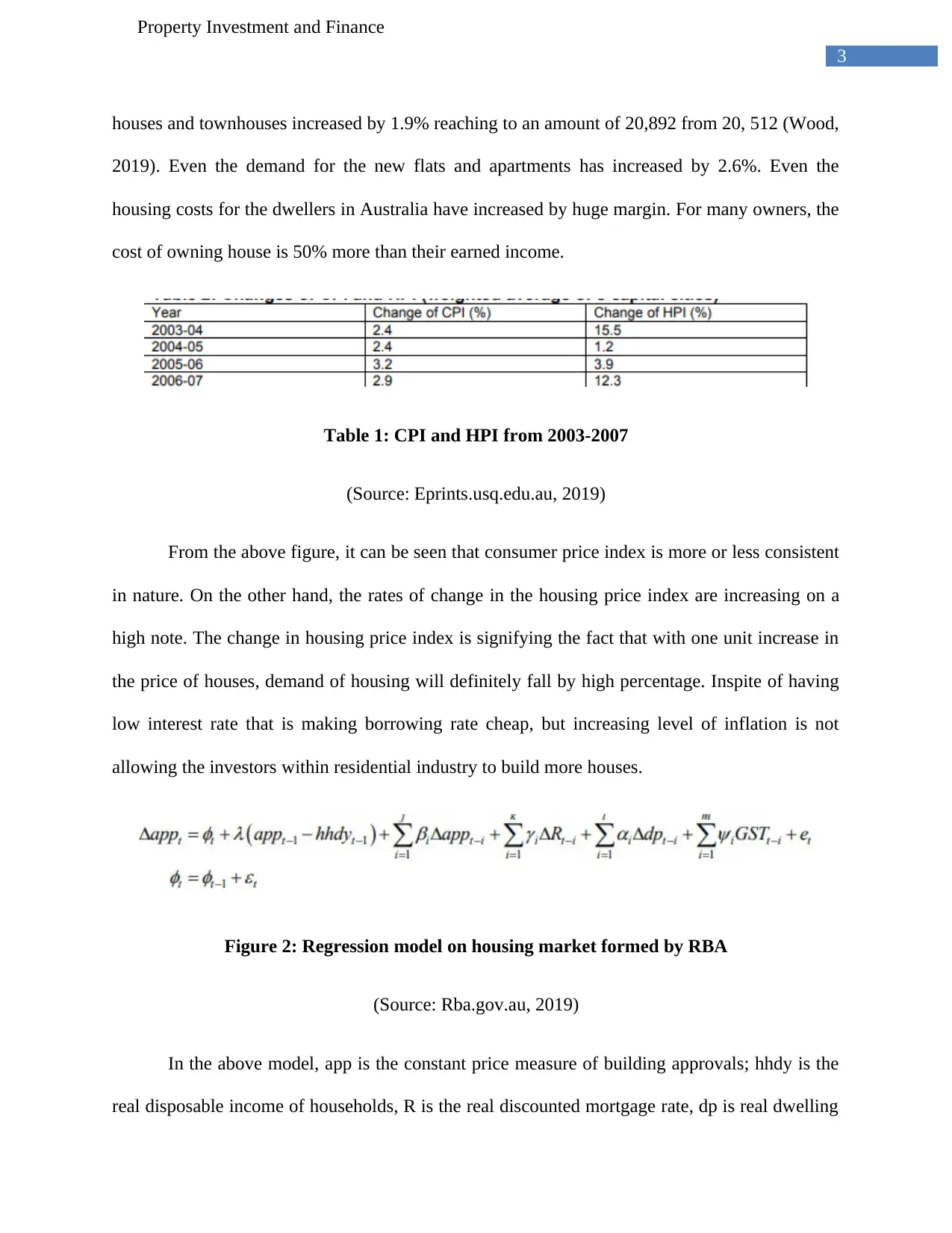
3
Property Investment and Finance
houses and townhouses increased by 1.9% reaching to an amount of 20,892 from 20, 512 (Wood,
2019). Even the demand for the new flats and apartments has increased by 2.6%. Even the
housing costs for the dwellers in Australia have increased by huge margin. For many owners, the
cost of owning house is 50% more than their earned income.
Table 1: CPI and HPI from 2003-2007
(Source: Eprints.usq.edu.au, 2019)
From the above figure, it can be seen that consumer price index is more or less consistent
in nature. On the other hand, the rates of change in the housing price index are increasing on a
high note. The change in housing price index is signifying the fact that with one unit increase in
the price of houses, demand of housing will definitely fall by high percentage. Inspite of having
low interest rate that is making borrowing rate cheap, but increasing level of inflation is not
allowing the investors within residential industry to build more houses.
Figure 2: Regression model on housing market formed by RBA
(Source: Rba.gov.au, 2019)
In the above model, app is the constant price measure of building approvals; hhdy is the
real disposable income of households, R is the real discounted mortgage rate, dp is real dwelling
Property Investment and Finance
houses and townhouses increased by 1.9% reaching to an amount of 20,892 from 20, 512 (Wood,
2019). Even the demand for the new flats and apartments has increased by 2.6%. Even the
housing costs for the dwellers in Australia have increased by huge margin. For many owners, the
cost of owning house is 50% more than their earned income.
Table 1: CPI and HPI from 2003-2007
(Source: Eprints.usq.edu.au, 2019)
From the above figure, it can be seen that consumer price index is more or less consistent
in nature. On the other hand, the rates of change in the housing price index are increasing on a
high note. The change in housing price index is signifying the fact that with one unit increase in
the price of houses, demand of housing will definitely fall by high percentage. Inspite of having
low interest rate that is making borrowing rate cheap, but increasing level of inflation is not
allowing the investors within residential industry to build more houses.
Figure 2: Regression model on housing market formed by RBA
(Source: Rba.gov.au, 2019)
In the above model, app is the constant price measure of building approvals; hhdy is the
real disposable income of households, R is the real discounted mortgage rate, dp is real dwelling
Paraphrase This Document
Need a fresh take? Get an instant paraphrase of this document with our AI Paraphraser
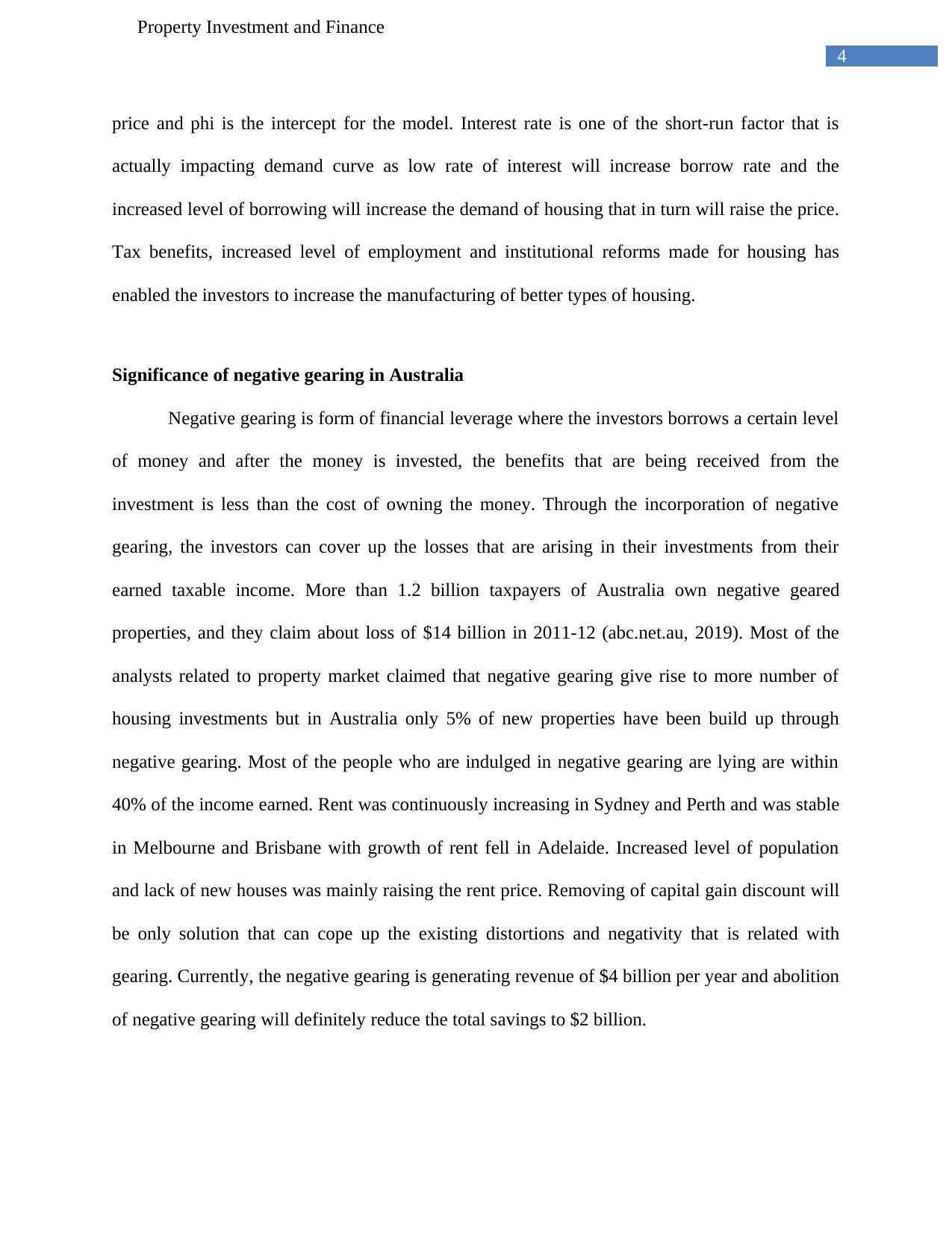
4
Property Investment and Finance
price and phi is the intercept for the model. Interest rate is one of the short-run factor that is
actually impacting demand curve as low rate of interest will increase borrow rate and the
increased level of borrowing will increase the demand of housing that in turn will raise the price.
Tax benefits, increased level of employment and institutional reforms made for housing has
enabled the investors to increase the manufacturing of better types of housing.
Significance of negative gearing in Australia
Negative gearing is form of financial leverage where the investors borrows a certain level
of money and after the money is invested, the benefits that are being received from the
investment is less than the cost of owning the money. Through the incorporation of negative
gearing, the investors can cover up the losses that are arising in their investments from their
earned taxable income. More than 1.2 billion taxpayers of Australia own negative geared
properties, and they claim about loss of $14 billion in 2011-12 (abc.net.au, 2019). Most of the
analysts related to property market claimed that negative gearing give rise to more number of
housing investments but in Australia only 5% of new properties have been build up through
negative gearing. Most of the people who are indulged in negative gearing are lying are within
40% of the income earned. Rent was continuously increasing in Sydney and Perth and was stable
in Melbourne and Brisbane with growth of rent fell in Adelaide. Increased level of population
and lack of new houses was mainly raising the rent price. Removing of capital gain discount will
be only solution that can cope up the existing distortions and negativity that is related with
gearing. Currently, the negative gearing is generating revenue of $4 billion per year and abolition
of negative gearing will definitely reduce the total savings to $2 billion.
Property Investment and Finance
price and phi is the intercept for the model. Interest rate is one of the short-run factor that is
actually impacting demand curve as low rate of interest will increase borrow rate and the
increased level of borrowing will increase the demand of housing that in turn will raise the price.
Tax benefits, increased level of employment and institutional reforms made for housing has
enabled the investors to increase the manufacturing of better types of housing.
Significance of negative gearing in Australia
Negative gearing is form of financial leverage where the investors borrows a certain level
of money and after the money is invested, the benefits that are being received from the
investment is less than the cost of owning the money. Through the incorporation of negative
gearing, the investors can cover up the losses that are arising in their investments from their
earned taxable income. More than 1.2 billion taxpayers of Australia own negative geared
properties, and they claim about loss of $14 billion in 2011-12 (abc.net.au, 2019). Most of the
analysts related to property market claimed that negative gearing give rise to more number of
housing investments but in Australia only 5% of new properties have been build up through
negative gearing. Most of the people who are indulged in negative gearing are lying are within
40% of the income earned. Rent was continuously increasing in Sydney and Perth and was stable
in Melbourne and Brisbane with growth of rent fell in Adelaide. Increased level of population
and lack of new houses was mainly raising the rent price. Removing of capital gain discount will
be only solution that can cope up the existing distortions and negativity that is related with
gearing. Currently, the negative gearing is generating revenue of $4 billion per year and abolition
of negative gearing will definitely reduce the total savings to $2 billion.
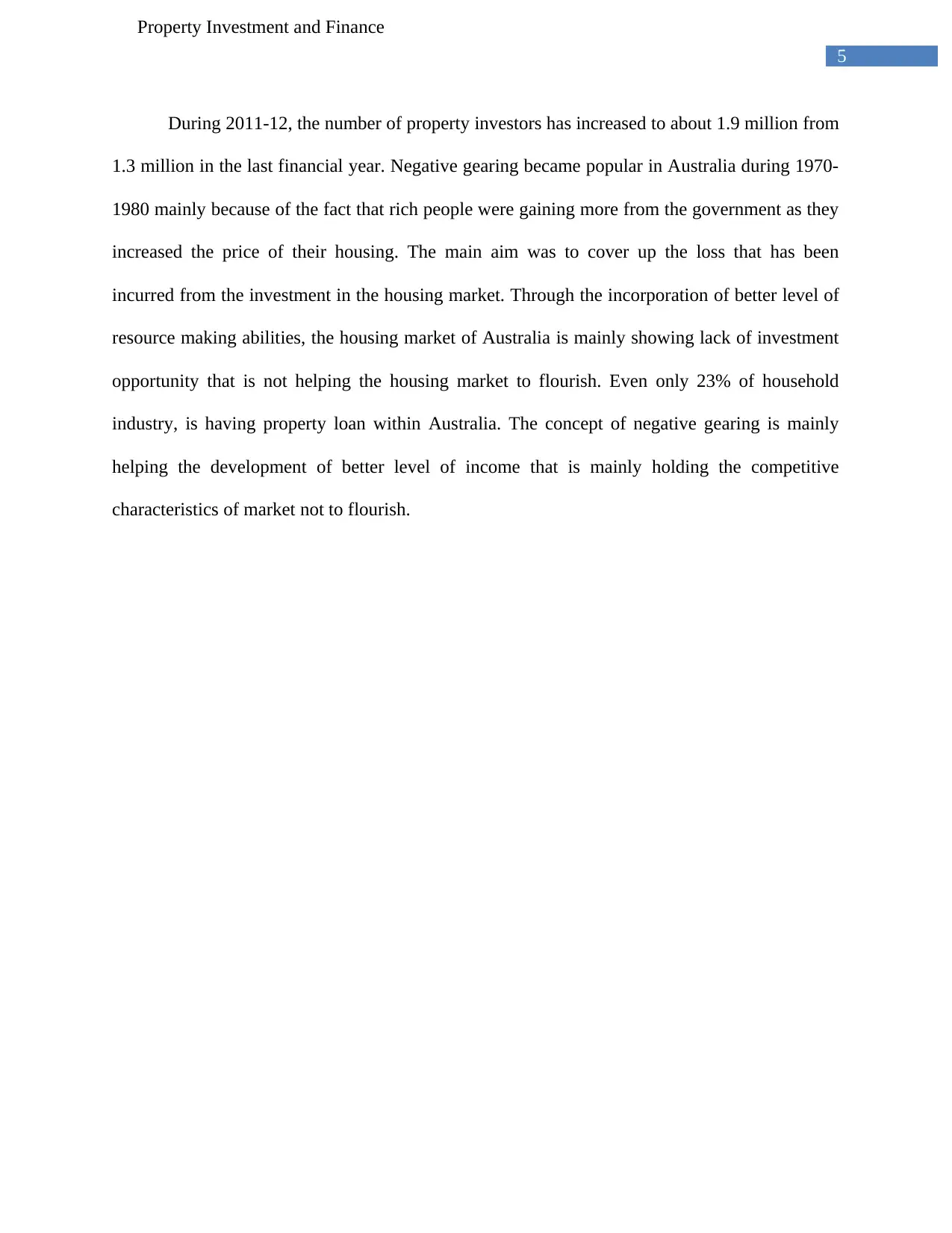
5
Property Investment and Finance
During 2011-12, the number of property investors has increased to about 1.9 million from
1.3 million in the last financial year. Negative gearing became popular in Australia during 1970-
1980 mainly because of the fact that rich people were gaining more from the government as they
increased the price of their housing. The main aim was to cover up the loss that has been
incurred from the investment in the housing market. Through the incorporation of better level of
resource making abilities, the housing market of Australia is mainly showing lack of investment
opportunity that is not helping the housing market to flourish. Even only 23% of household
industry, is having property loan within Australia. The concept of negative gearing is mainly
helping the development of better level of income that is mainly holding the competitive
characteristics of market not to flourish.
Property Investment and Finance
During 2011-12, the number of property investors has increased to about 1.9 million from
1.3 million in the last financial year. Negative gearing became popular in Australia during 1970-
1980 mainly because of the fact that rich people were gaining more from the government as they
increased the price of their housing. The main aim was to cover up the loss that has been
incurred from the investment in the housing market. Through the incorporation of better level of
resource making abilities, the housing market of Australia is mainly showing lack of investment
opportunity that is not helping the housing market to flourish. Even only 23% of household
industry, is having property loan within Australia. The concept of negative gearing is mainly
helping the development of better level of income that is mainly holding the competitive
characteristics of market not to flourish.
⊘ This is a preview!⊘
Do you want full access?
Subscribe today to unlock all pages.

Trusted by 1+ million students worldwide
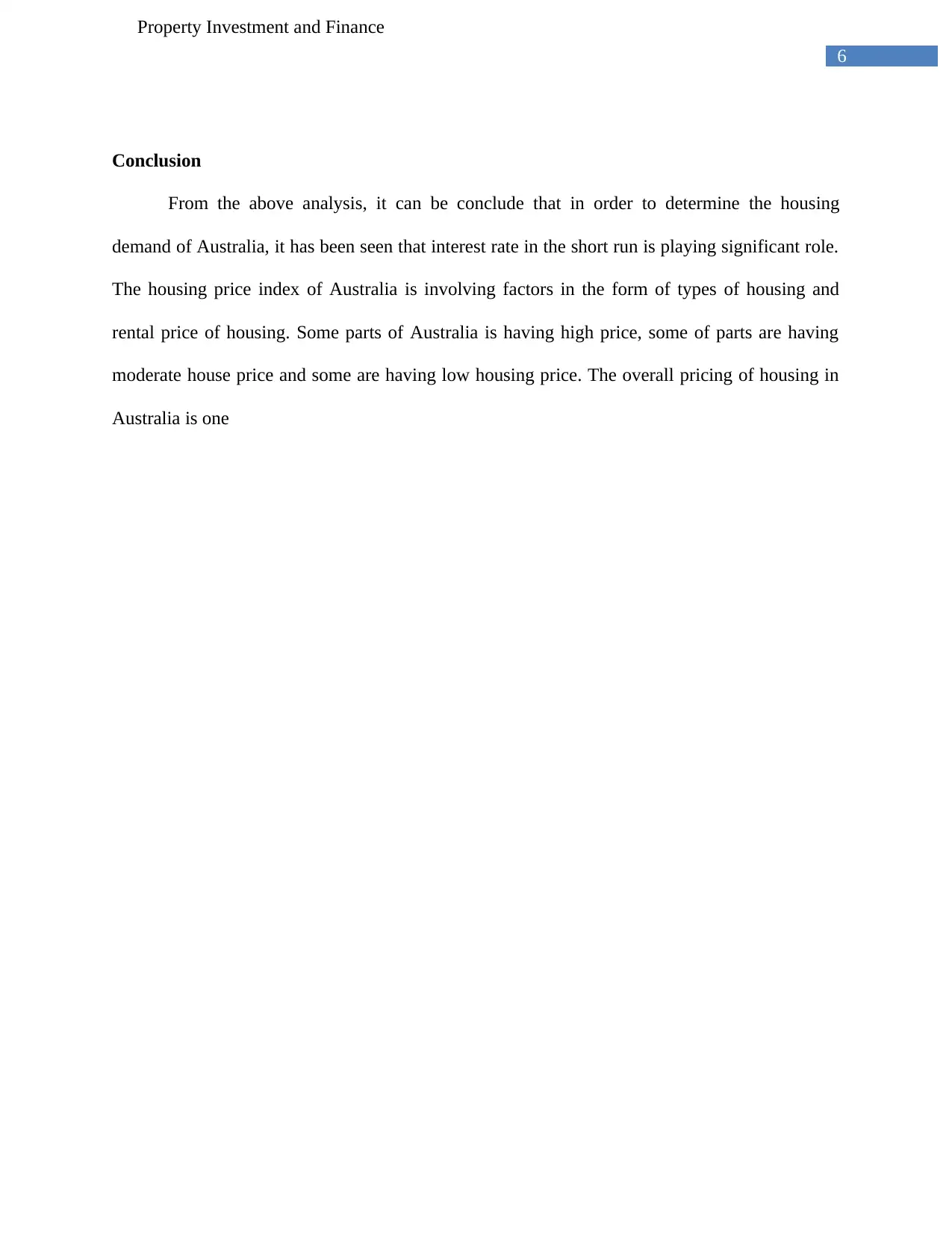
6
Property Investment and Finance
Conclusion
From the above analysis, it can be conclude that in order to determine the housing
demand of Australia, it has been seen that interest rate in the short run is playing significant role.
The housing price index of Australia is involving factors in the form of types of housing and
rental price of housing. Some parts of Australia is having high price, some of parts are having
moderate house price and some are having low housing price. The overall pricing of housing in
Australia is one
Property Investment and Finance
Conclusion
From the above analysis, it can be conclude that in order to determine the housing
demand of Australia, it has been seen that interest rate in the short run is playing significant role.
The housing price index of Australia is involving factors in the form of types of housing and
rental price of housing. Some parts of Australia is having high price, some of parts are having
moderate house price and some are having low housing price. The overall pricing of housing in
Australia is one
Paraphrase This Document
Need a fresh take? Get an instant paraphrase of this document with our AI Paraphraser
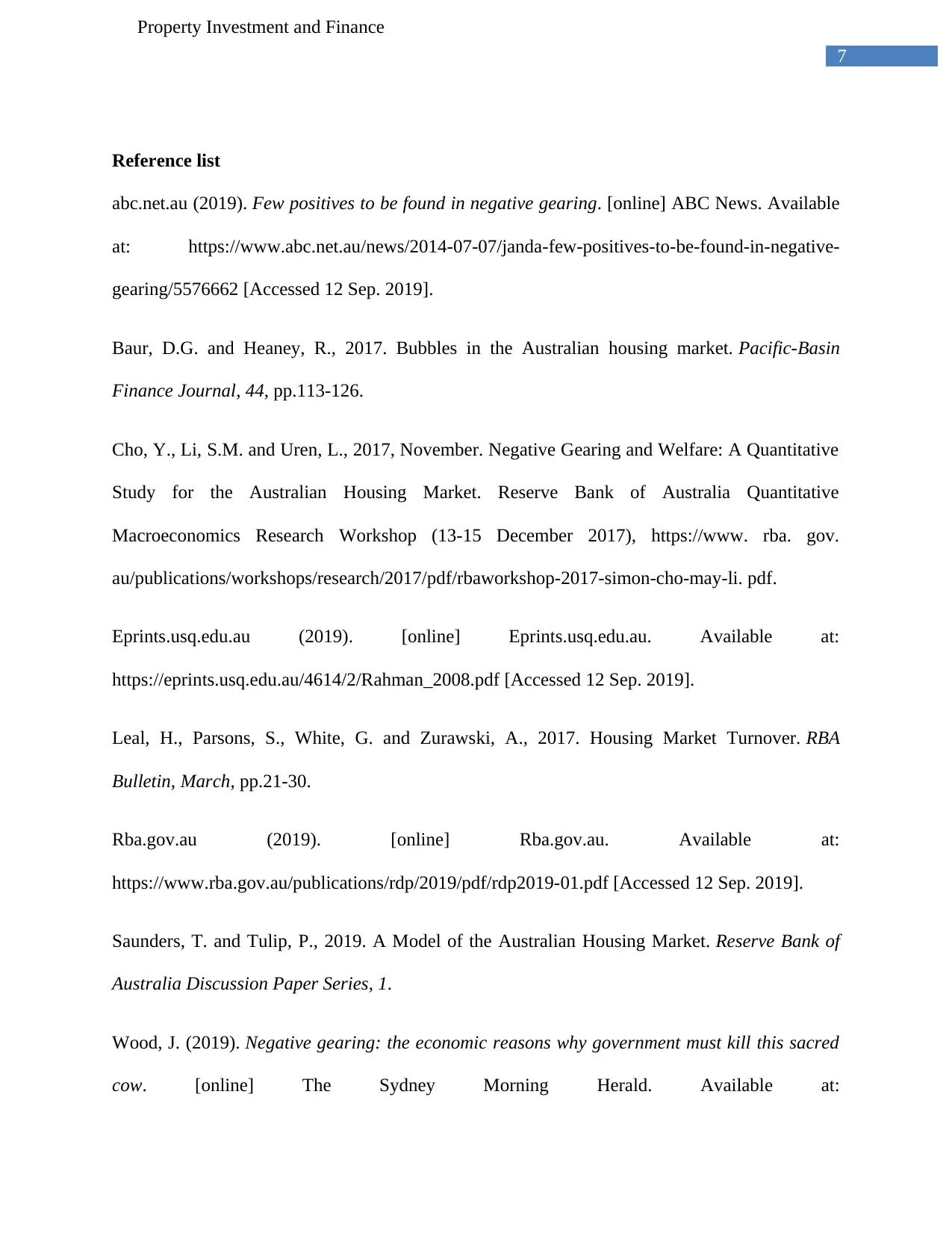
7
Property Investment and Finance
Reference list
abc.net.au (2019). Few positives to be found in negative gearing. [online] ABC News. Available
at: https://www.abc.net.au/news/2014-07-07/janda-few-positives-to-be-found-in-negative-
gearing/5576662 [Accessed 12 Sep. 2019].
Baur, D.G. and Heaney, R., 2017. Bubbles in the Australian housing market. Pacific-Basin
Finance Journal, 44, pp.113-126.
Cho, Y., Li, S.M. and Uren, L., 2017, November. Negative Gearing and Welfare: A Quantitative
Study for the Australian Housing Market. Reserve Bank of Australia Quantitative
Macroeconomics Research Workshop (13-15 December 2017), https://www. rba. gov.
au/publications/workshops/research/2017/pdf/rbaworkshop-2017-simon-cho-may-li. pdf.
Eprints.usq.edu.au (2019). [online] Eprints.usq.edu.au. Available at:
https://eprints.usq.edu.au/4614/2/Rahman_2008.pdf [Accessed 12 Sep. 2019].
Leal, H., Parsons, S., White, G. and Zurawski, A., 2017. Housing Market Turnover. RBA
Bulletin, March, pp.21-30.
Rba.gov.au (2019). [online] Rba.gov.au. Available at:
https://www.rba.gov.au/publications/rdp/2019/pdf/rdp2019-01.pdf [Accessed 12 Sep. 2019].
Saunders, T. and Tulip, P., 2019. A Model of the Australian Housing Market. Reserve Bank of
Australia Discussion Paper Series, 1.
Wood, J. (2019). Negative gearing: the economic reasons why government must kill this sacred
cow. [online] The Sydney Morning Herald. Available at:
Property Investment and Finance
Reference list
abc.net.au (2019). Few positives to be found in negative gearing. [online] ABC News. Available
at: https://www.abc.net.au/news/2014-07-07/janda-few-positives-to-be-found-in-negative-
gearing/5576662 [Accessed 12 Sep. 2019].
Baur, D.G. and Heaney, R., 2017. Bubbles in the Australian housing market. Pacific-Basin
Finance Journal, 44, pp.113-126.
Cho, Y., Li, S.M. and Uren, L., 2017, November. Negative Gearing and Welfare: A Quantitative
Study for the Australian Housing Market. Reserve Bank of Australia Quantitative
Macroeconomics Research Workshop (13-15 December 2017), https://www. rba. gov.
au/publications/workshops/research/2017/pdf/rbaworkshop-2017-simon-cho-may-li. pdf.
Eprints.usq.edu.au (2019). [online] Eprints.usq.edu.au. Available at:
https://eprints.usq.edu.au/4614/2/Rahman_2008.pdf [Accessed 12 Sep. 2019].
Leal, H., Parsons, S., White, G. and Zurawski, A., 2017. Housing Market Turnover. RBA
Bulletin, March, pp.21-30.
Rba.gov.au (2019). [online] Rba.gov.au. Available at:
https://www.rba.gov.au/publications/rdp/2019/pdf/rdp2019-01.pdf [Accessed 12 Sep. 2019].
Saunders, T. and Tulip, P., 2019. A Model of the Australian Housing Market. Reserve Bank of
Australia Discussion Paper Series, 1.
Wood, J. (2019). Negative gearing: the economic reasons why government must kill this sacred
cow. [online] The Sydney Morning Herald. Available at:

8
Property Investment and Finance
https://www.smh.com.au/opinion/negative-gearing-the-economic-reasons-why-government-
must-kill-this-sacred-cow-20150317-1m14s4.html [Accessed 12 Sep. 2019].
Property Investment and Finance
https://www.smh.com.au/opinion/negative-gearing-the-economic-reasons-why-government-
must-kill-this-sacred-cow-20150317-1m14s4.html [Accessed 12 Sep. 2019].
⊘ This is a preview!⊘
Do you want full access?
Subscribe today to unlock all pages.

Trusted by 1+ million students worldwide
1 out of 9
Related Documents
Your All-in-One AI-Powered Toolkit for Academic Success.
+13062052269
info@desklib.com
Available 24*7 on WhatsApp / Email
![[object Object]](/_next/static/media/star-bottom.7253800d.svg)
Unlock your academic potential
Copyright © 2020–2025 A2Z Services. All Rights Reserved. Developed and managed by ZUCOL.




